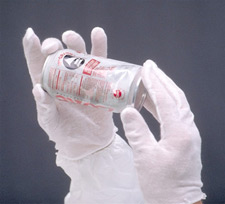- 01: Introduction
- 02: History
- 03: Propellants, Firearms, and Ammunition Development
- 04: Modern Firearms Manufacture
- 05: Small Arms Ammunition
- 06: Evidence Handling Procedures
- Introduction
- Objectives
- AFTE Knowledge and Ability Factors
- Types of Evidence
- Associative Evidence
- The Crime Scene
- Evidence Submission
- Laboratory Evidence Handling
- Case Tracking Within the Laboratory
- Firearm and Toolmark Examination Considerations
- Selected Bibliography
- 07: Equipment and Instrumentation
- 08: Examination of Firearms
- 09: Cartridge and Shotshell Examination
- 10: Characterization and Evaluation of Fired Projectiles
- 11: Bullet Comparison and Identification
- 12: Gunshot Residue and Distance Determination
- 13: Toolmark Identification
- 14: Communicating Results
- Resources


Integrity
Home > Evidence Handling Procedures > Types of Evidence > Physical Evidence > Integrity

Personal protective equipment
Protection of trace evidence from loss or contamination is essential. In some instances, such as footwear or tire track impressions, the procedure used to collect the evidence is critical to the protection of its integrity. For example, special techniques are required to collect castings of impressions in snow. In regard to contamination, crime scene personnel must wear gloves when collecting evidence to prevent transfer of their DNA.
Special attention must be paid to items that will be processed for latent prints. These must be packaged and handled in a way that prevents the deposit of additional prints or smearing of evidence prints before visualization.
There are some cases where discussion between laboratory personnel is advised to determine the sequence of examination. For example, a firearm may be submitted to the laboratory with a request for latent print and DNA examination. Firearm examiners will need to ensure the weapon is safe for handling without compromising latent print and DNA evidence (per laboratory protocol). Some latent print visualization techniques can damage DNA, but latent print examiners would prefer to process the evidence before excessive handling takes place.
Physical evidence can be significantly degraded due to the effects of environmental factors before and/or after recovery.
The amount of evidentiary value is typically in inverse proportion to the duration and intensity of exposure to the following:
- Living organisms (bacteria, molds, insects, animals)
- Weather conditions (temperature, humidity, rain)
- The chemistry of a hostile environment (substrate at the location, soil pH)
- Superstrate (a covering of soil and its chemistry)
- The amount of time interacting with any or all of the above
Improper collection and preservation, inadequate storage conditions, or carelessness within a laboratory can be as destructive to physical evidence as years of exposure in the external environment.
Examples of degraded physical evidence within the field of firearms identification include the following:
- A rusted firearm barrel (may preclude identification)
- Oxidation of a lead bullet in soil
- Oxidation of the surface of a jacketed bullet due to a lengthy exposure to human tissue
- Clothing exposed to weather (may result in leached patterns of gunshot residues)




